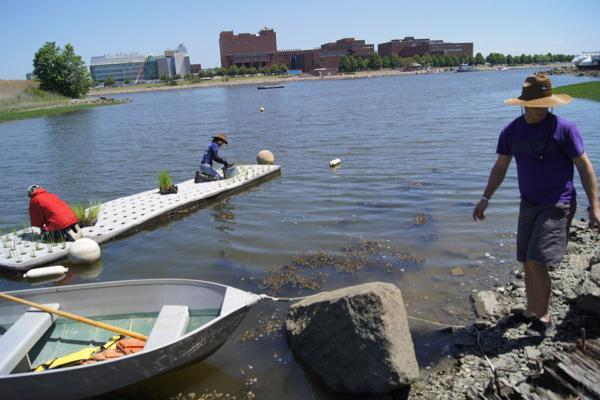June 5, 2014

Savin Hill’s Mary Talalas, left, and Dr. Anamarija Frankic of UMass-Boston’s Green Harbors Project planted new cord grass on a non-tox island in Savin Hill Cove. Photo by Nancy Talalas
A team led by a UMass Boston professor is expanding its work to restore and study conditions in Savin Hill Cove this season. The salt marsh, a part of Dorchester Bay that is bisected by Morrissey Boulevard, has some of the poorest water quality in the city, but is an ideal place to study and test new approaches to protecting the fragile coastline environment.
Dr. Anamarija Frankic, director of the university’s Green Harbors Project (GHP) and a research professor at UMass Boston’s School for the Environment, often uses the cove as an outdoor classroom. Much of her work has focused on water quality and how it impacts oysters and other native species that are found in the coves two sections, which includes Patten’s Cove, closest to the Boston Globe property and Savin Hill.
Last week, Frankic and her team— including 12 year-old Savin Hill resident Mary Talalas and her mom, Nancy— planted cord grass on a “floating island” that was installed in the cove last November. The island is made of a non-toxic plastic material with holes for plants to grow on.
Through a collaboration with the Biomimicry Living Labs, the GHP received a $100,000 grant from the Schmidt Family Foundation and they were able to begin the project at Savin Hill Cove last year.The project has already helped to organize clean-ups, made possible by the state’s Department of Conservation and Recreation (DCR), aimed at removing junk that has accumulated there over the decades.
“We first organized it with DCR and they helped clean up 19 tons of trash and marine debris,” said Dr. Frankic, who lives in Quincy. “But, even with that huge amount of debris, it was just a little dent.”
Among the debris hauled away were old docks that had been rotting for years and even bottles from the 1950s.
Frankic’s goal is to create a living lab in the cove, while also making the area safer and cleaner for use by the local community, who’ve been plugged into Frankic’s plans through the local civic association.
Twelve year-old Mary Talalas, who lives on nearby Grampian Way, got involved as part of a school research project which earned her both a state and national award. Talalas joined Dr. Frankic and some of her students last Saturday to plant on the floating island, which Frankic says is the first of its kind in Boston Harbor.
Frankic says the project will return on June 13 to test new water quality testing equipment—part of a collaboration with Olin College of Engineering.
“It’s a great place to learn about the history of Boston, of its people and traditions, but also about nature and how this place looked before we moved here, even before Native Americans. It’s perfect for what I’m teaching my students, which is how we repair our urban harbors. We would like to help restore these salt marshes and shellfish beds and in the process, help to prevent erosion and flooding. It’s a win-win.”
To learn more about the Green Harbors Project visit umb.edu/ghp.
Reporter editor Bill Forry contributed to this report.
Topics:



